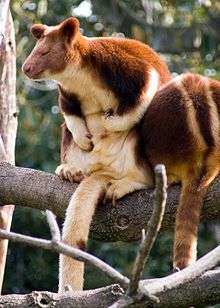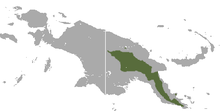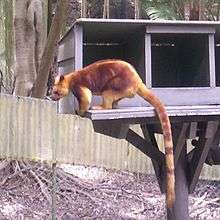Goodfellow's tree-kangaroo
Goodfellow's tree-kangaroo (Dendrolagus goodfellowi) also called the ornate tree-kangaroo, belongs to the family Macropodidae, which includes kangaroos, wallabies and their relatives,[4] and the genus Dendrolagus, with eleven other species.[1] The species is native to the rainforests of New Guinea, and the border of central Irian Jaya in Indonesia.[5] Under the IUCN classification, the species is listed as Endangered,[2] which is a result of overhunting and human encroachment on their habitat.[6] It is named after British zoological collector Walter Goodfellow.[7]
| Goodfellow's tree-kangaroo[1] | |
|---|---|
 | |
| Scientific classification | |
| Kingdom: | Animalia |
| Phylum: | Chordata |
| Class: | Mammalia |
| Infraclass: | Marsupialia |
| Order: | Diprotodontia |
| Family: | Macropodidae |
| Genus: | Dendrolagus |
| Species: | D. goodfellowi |
| Binomial name | |
| Dendrolagus goodfellowi | |
 | |
| Goodfellow's tree-kangaroo range | |
Names
It is known as kabacp (kabcp) in the Kalam language of Papua New Guinea.[8]
Taxonomy
There are two subspecies of the Goodfellow's tree-kangaroo:[1]
- Dendrolagus goodfellowi goodfellowi
- Dendrolagus goodfellowi buergersi – Buergers' tree-kangaroo
Description
Like other tree-kangaroos, Goodfellow's tree-kangaroo is quite different in appearance from terrestrial kangaroos. Unlike its land dwelling cousins, its legs are not disproportionately large compared to its forelimbs which are strong and end in hooked claws for grasping tree limbs, and it has a long tail for balance. All of these features help it with a predominantly arboreal existence. Goodfellow's tree-kangaroo has short, woolly fur,[9] usually chestnut to red-brown in colour, a grey-brown face, yellow-coloured cheeks and feet; a pale belly,[10] a long, golden brown tail, and two golden stripes on its backside.[11] It weighs approximately 7 kg (about 15 lb).[5]
Behaviour
Goodfellow's tree-kangaroo is slow and clumsy on the ground, moving at about walking pace and hopping awkwardly, leaning its body far forward to balance the heavy tail. However, in trees it is bold and agile. It climbs by wrapping its forelimbs around the trunk of a tree and hopping with the powerful hind legs, allowing the forelimbs to slide. It has extraordinary jumping ability and has been known to jump to the ground from heights of 30 feet without harm .[11]
Diet
Although it feeds mainly on the leaves of the Silkwood tree[12] (Flindersia pimenteliana), other morsels are accepted when available, including various fruits, cereals, flowers and grasses.[10] It has a large stomach that functions as a fermentation vat, similar to the stomachs of cows and other ruminant herbivores, where bacteria break down fibrous leaves and grasses.[13]
Gallery
 Dendrolagus goodfellowi
Dendrolagus goodfellowi
 At Melbourne Zoo, Australia
At Melbourne Zoo, Australia At Currumbin Wildlife Sanctuary, Queensland, Australia
At Currumbin Wildlife Sanctuary, Queensland, Australia
See also
References
- Groves, C. P. (2005). Wilson, D. E.; Reeder, D. M. (eds.). Mammal Species of the World: A Taxonomic and Geographic Reference (3rd ed.). Baltimore: Johns Hopkins University Press. pp. 59–60. ISBN 0-801-88221-4. OCLC 62265494.
- Leary, T.; Seri, L.; Wright, D.; Hamilton, S.; Helgen, K.; Singadan, R.; Menzies, J.; Allison, A.; James, R.; Dickman, C.; et al. (2008). "Dendrolagus goodfellowi". IUCN Red List of Threatened Species. 2008. Retrieved 28 December 2008.CS1 maint: ref=harv (link) Database entry includes justification for why this species is listed as endangered.
- Thomas, Oldfield (1908). "A new Tree-Kangaroo from British New Guinea". The Annals and Magazine of Natural History. Ser. 8. 2 (11): 452–453.
- Myers, P. (2001). "Macropodidae". Animal Diversity Web. Retrieved 2006-08-05.
- Animal Info (1999-2005). Animal Info - Goodfellow's Tree Kangaroo. Retrieved August 3, 2006.
- Currumbin Wildlife Sanctuary (2006). Goodfellow's Tree-kangaroo - captive breeding program. Retrieved August 3, 2006.
- Beolens, Bo; Watkins, Michael; Grayson, Michael (2009-09-28). The Eponym Dictionary of Mammals. Baltimore: The Johns Hopkins University Press. pp. 158–9. ISBN 978-0-8018-9304-9. OCLC 270129903.
- Pawley, Andrew and Ralph Bulmer. 2011. A Dictionary of Kalam with Ethnographic Notes. Canberra. Pacific Linguistics.
- Melbourne Zoo (2006). Animal Fact Sheet: Goodfellow's Tree-Kangaroo Archived 2006-08-19 at the Wayback Machine. Retrieved August 3, 2006.
- Discovery Communications Inc. (2006). Goodfellow's tree kangaroo. Retrieved August 3, 2006.
- World Wildlife Fund (2006). Tree Kangaroos Archived 2006-09-15 at the Wayback Machine. Retrieved August 3, 2006.
- "Goodfellow's tree kangaroo". Funk & Wagnalls Wildlife Encyclopedia. 20. New York, N.Y.: Funk and Wagnalls. 1974. p. 2397.
- Johnson, S. (1999). "Dendrolagus goodfellowi". Animal Diversity Web. Retrieved 2006-08-03.
